“A lot of people come up to me and say, ‘You made an ugly car look good.’”
Wait…what?
“It’s kind of flattering, actually, because that’s what I wanted to do. I didn’t like the look of it, either!” Paul Rivard said, laughing.
It’s strange to hear such a dedicated Camaro fanatic refer to his car—a 1974 Type LT—in such harsh terms. And Paul’s definitely into Camaros; he’s owned more than you can count on both hands.
So what is it about the Bowtie Brand’s iconic muscle car, specifically the second generation?
“Part of it is, I had my first Camaro at 18; a ’71 Rally Sport. I just always liked them. Before that I had a ’79 Trans Am and I ended up smacking it up. I got the insurance money from that and bought the Camaro, and that was it from then on.”
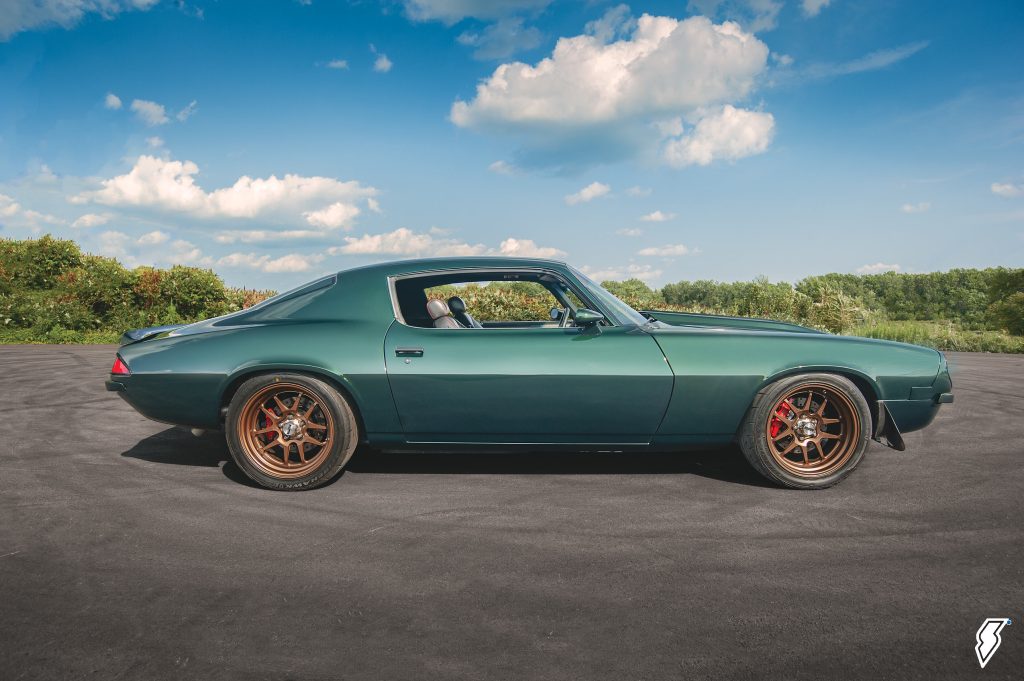
Paul’s story probably sounds familiar to many of the enthusiasts reading this.
The Massachusetts native, who “was always the kid who took stuff apart and put it back together,” got his start customizing bicycles. “We were cutting forks off one bike and sliding them on the ends of another one, welding them on, and making our own choppers at eight, ten years old,” he said. His father owned a trucking company with a fully stocked repair shop where he began welding by the age of ten.
Of course, it wasn’t long before he was trying to go faster. “We took a go-kart, we took the little five horse motor off, put a dirt bike motor on, and almost killed ourselves!” he chuckled.
As expected, go-karts led quickly to cars. “When I was 14, I had a ’67 Mustang and I was gonna restore it. I had all the plans in the world. But it was well above my head because it was all rotted beyond repair,” Paul said.
While that project sputtered, he soon dug into his first build. “I bought a ’70 Monte Carlo for a hundred bucks with a window in the side of the block. I call it a window—it had a hole; it threw a rod. So I got a 350 block, put the 327/350 horse Crane Cam in there that everybody used back then, and put a Holley 750 on it. That’s probably the first car I did anything to,” he said.
Further along, in 2009, he completely restored a badly rusted 1971 Nova for drag racing. A nitrous mishap scattered the engine and gave Paul the perfect opportunity to remake it as a pro touring ride. “I transitioned from a drag car to a street car in one winter. I was determined to have that car out in the spring,” he said.
Now the owner of a classic muscle car that could do more than go fast in a straight line, Paul tried his hand at autocross—and he was hooked.
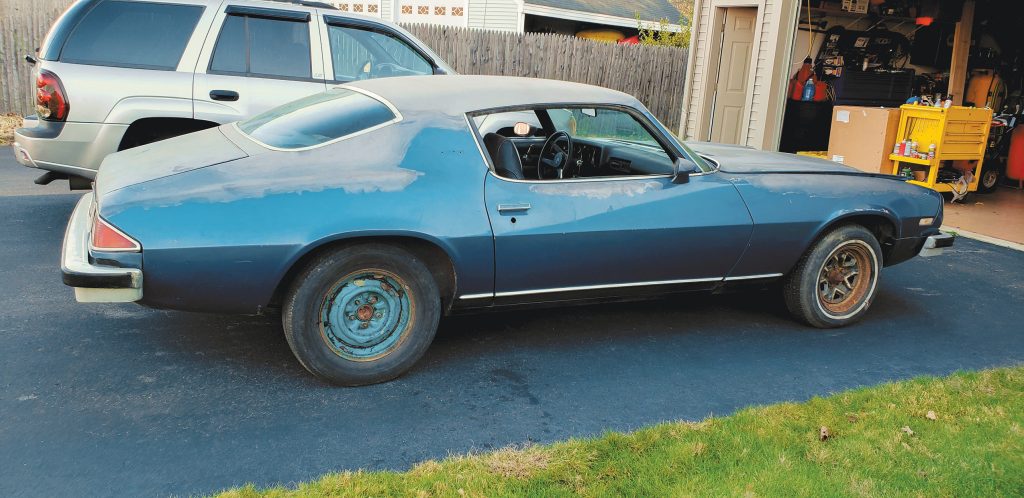
That leads us to this 1974 Camaro.
Originally from California, this car turned up in Paul’s then-home state New Hampshire back in October 2018. He wasted no time getting elbow-deep in the project. “I bought it, drove it home, put it in the garage, and two hours later it was a shell. It doesn’t take long for me to take one of these apart. I can have this thing down to nothing—if I’m not concerned about scratching anything, if I’m just tearing it apart—couple of hours it’s down to a body,” Paul said.
The questions that immediately come to mind are obvious: How does he catalog the parts? How does he remember how to put it back together?
That’s where being a second-gen F-body fanatic pays off. “Well, I’ve got three of ’em. I’ve probably owned 15 of them in my lifetime, maybe more. The ’77 I just bought is pretty much all original, so if I need reference on something…for the most part I know the cars well enough, but there’s still some things I need to reference,” he said, matter-of-factly.
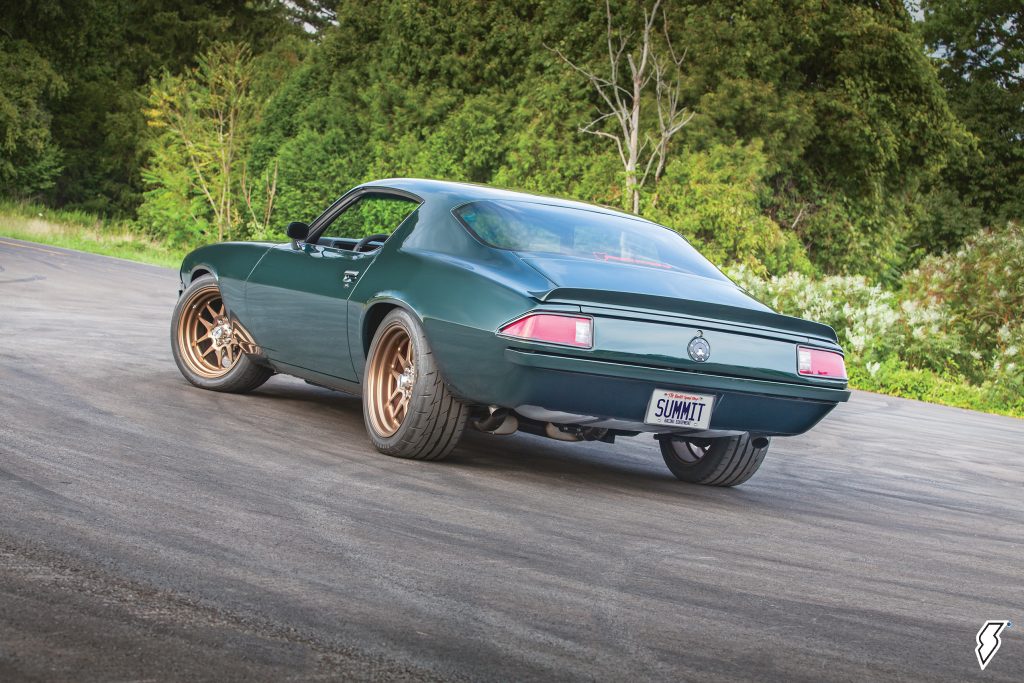
The 1974 Chevy Camaro is unique. It’s a one-year-only style that features the smaller rear window of the 1970-73 cars, and new-design impact bumpers that stick way out there.
Paul set out to correct the unsightly bumper issue and weighed his options.
“I actually was trying to figure out a way to put ’70 front and rear bumpers on it,” he said. He settled on a set of aftermarket bumpers intended for oval-track racing and used his self-taught metalworking skills to massage, tweak, and tuck them in.
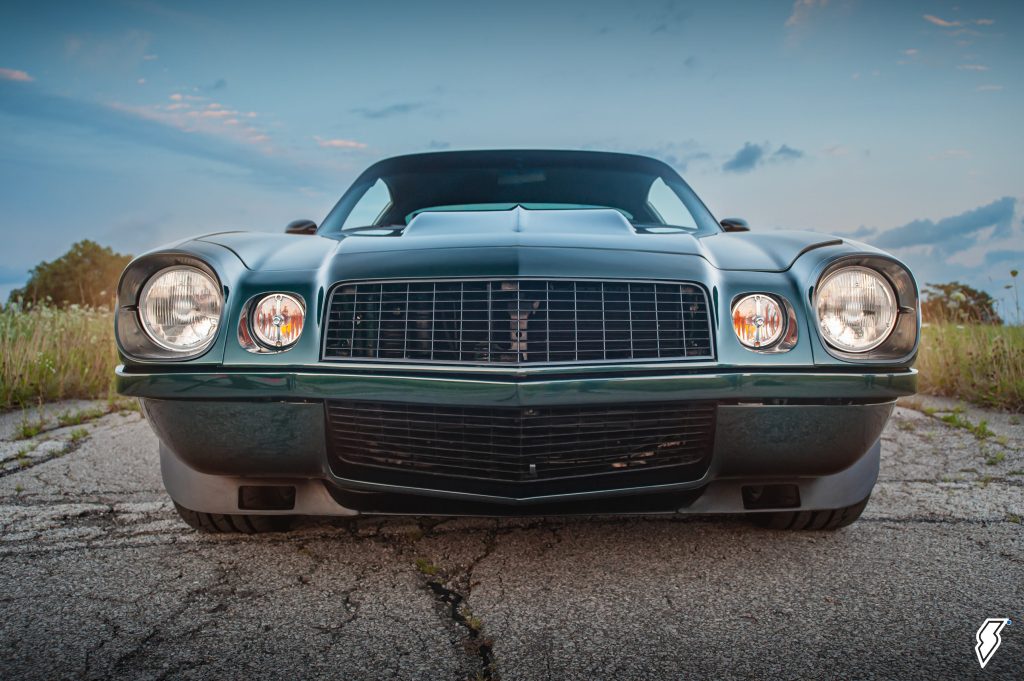
Going far beyond replacing the bumpers, Paul ended up massively restyling both ends of the car. Up front, the fiberglass valence panel was reworked and a lower grill was added. “The lower grill is an upper grill flipped upside-down, and it fit right in. It literally dropped right into place and I’m like, ‘It can’t be this easy,’” Paul said.
A 1977 Z28 chin spoiler completes the low-slung look.
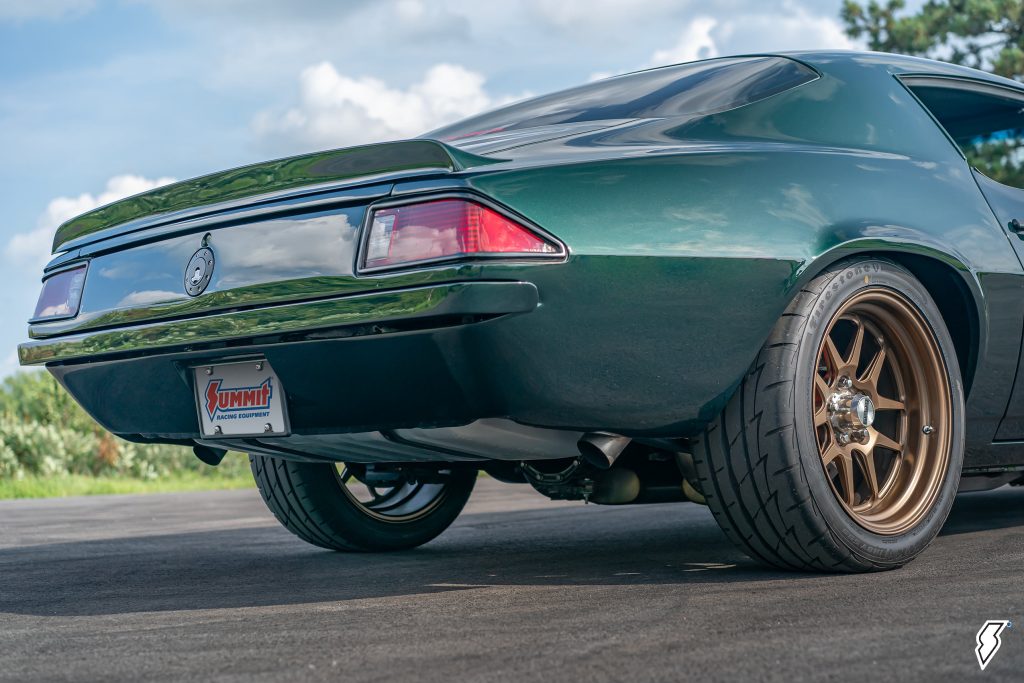
Out back, the license plate was moved below the bumper to a modified valence panel. “It’s all steel. I made one side, got it to where I wanted to, took cardboard, cut three levels of the pattern, and just kept bending the other side until each piece fit,” Paul said.
The space between the taillights was filled in, creating the perfect spot for the Ridetech fuel filler, a piece designed for 1967-68 Camaros. A 1970 Camaro spoiler provides the finishing touch.
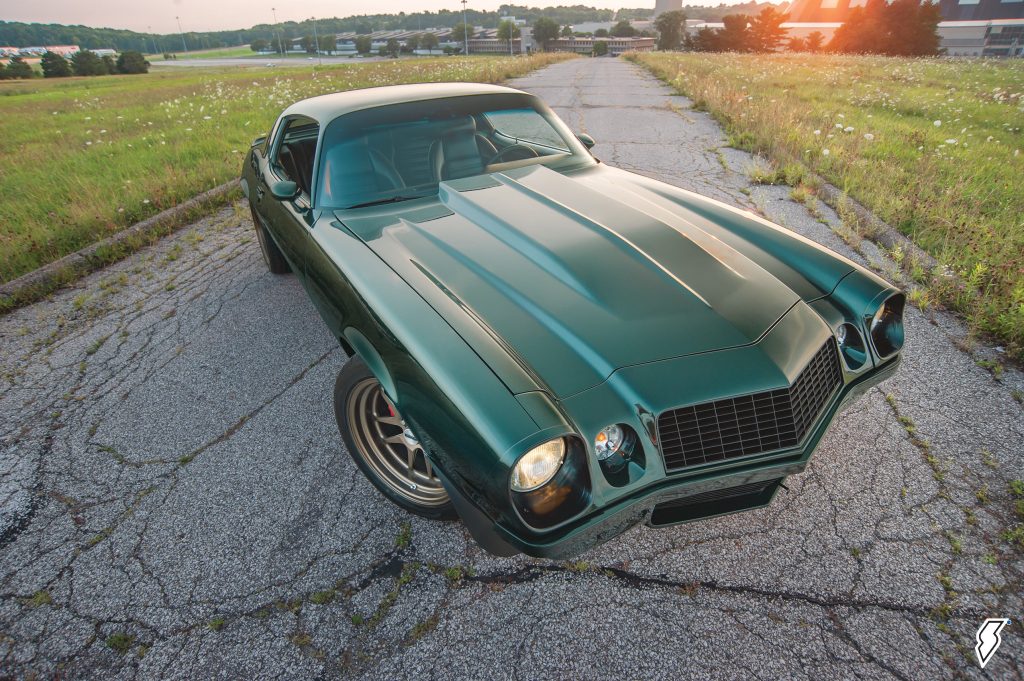
Even more involved was the installation of flush front and rear glass. While they create a much smoother, more modern look, they didn’t exactly drop right in. Paul put about 30 hours into each window to get it to fit just right.
Where did Paul acquire the skills for such extensive modifications?
“Just trial and error. Trial and error, and the guy who painted it’s been a friend of mine for 30 years. He helped me with a lot of the basics,” he said, adding, “The beginning of my career as an automotive tech was Meineke. I used to do custom exhausts; that’s what I did all day, every day. I built headers for AC Cobras and stuff like that. So, I could fabricate. I had a good sense of ‘Alright, I gotta bend this here to do this.’ I put the same thing into this.”
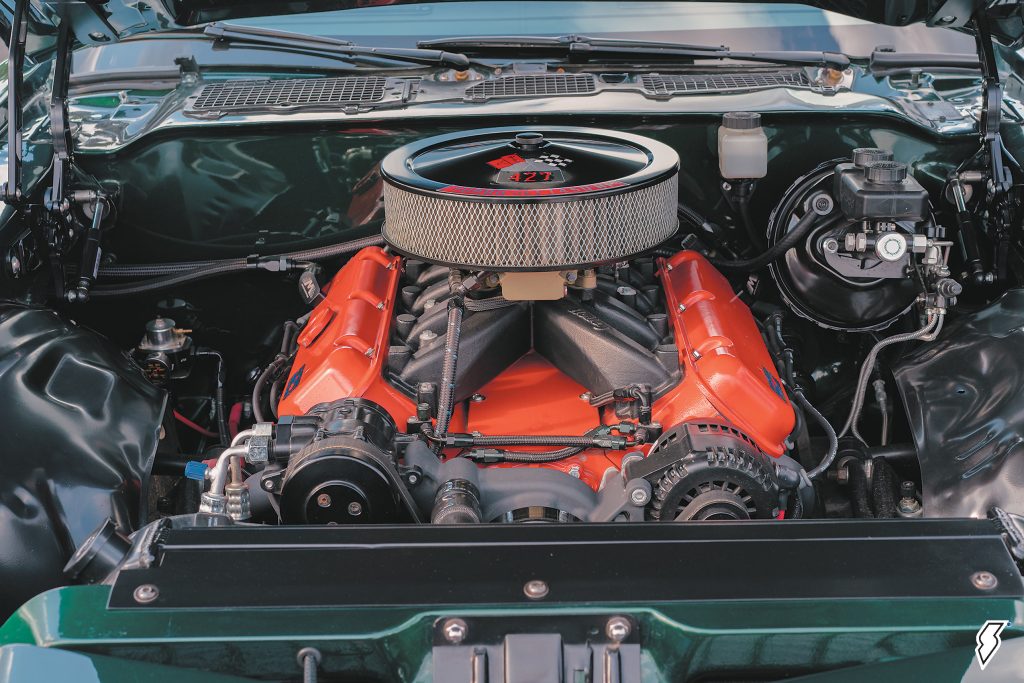
Of course, all that metalwork and the beautiful GM Emerald Green Metallic finish, applied by Mike Beaulieu, owner of Mike’s Auto Body in Merrimack, NH, would be little more than window dressing if the Camaro didn’t have the goods to back it up.
A 427ci LS3 sends its 610 hp and 574 ft.-lbs. through a TREMEC Magnum 6-speed and on to a Moser 12-bolt rear end.
“I only have a 3.55 gear in it, and I did that for autocross. That Nova I built had a 3.70 in it. With Goodguys, they make all their autocross courses relatively the same. What was happening was, they have a pretty good straightaway section and I was starting to hit the rev limiter with the Nova. So I said, ‘Well, let’s step it down to a 3.55 so I can stay in first gear and not worry about hitting the rev limiter a lot.’”
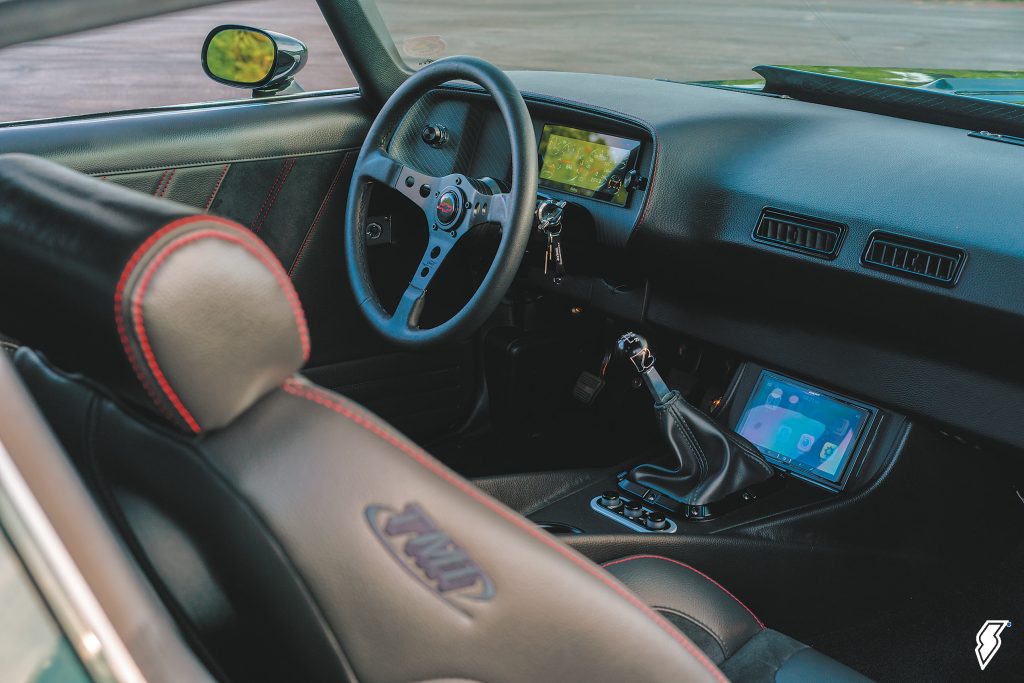
The relatively tall rear end ratio also makes it a great road-tripper. “With the six-speed, I can run this thing on the highway at 80 right now, drop it into sixth gear, and it’s at like 2,200 rpm—it gets 18 miles per gallon! If you had 600 horsepower in 1974, you’d be getting gallons per mile, not miles per gallon,” Paul laughed.
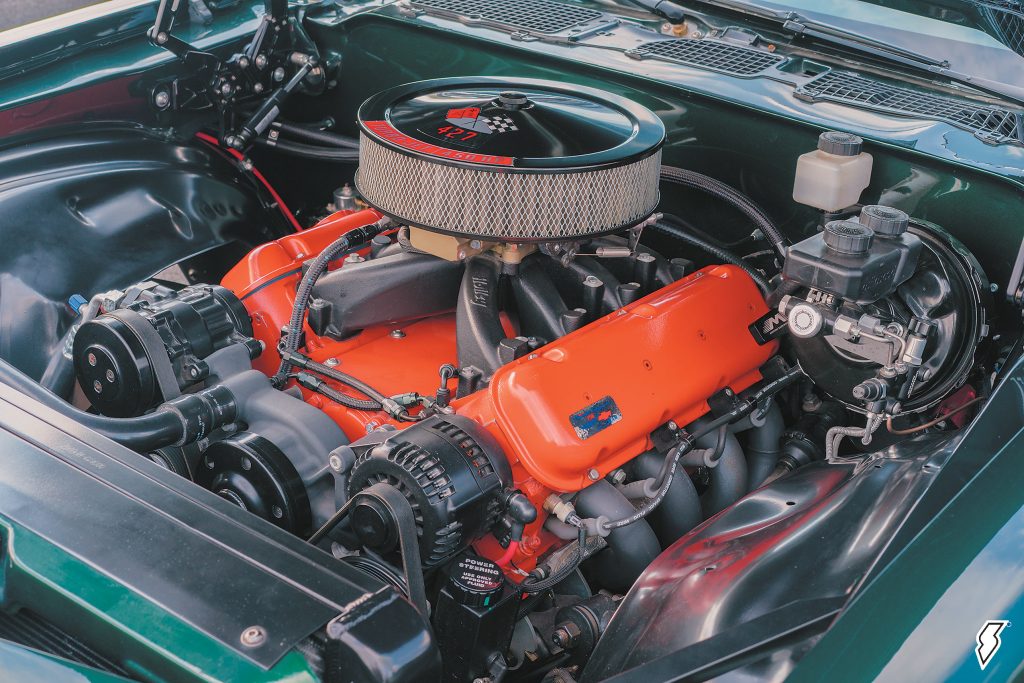
Not only does the efficient LS mill sport big block displacement and power, it looks the part, too.
LS Classic big block-style valve covers, a Summit Racing™ air filter, Holley Terminator Stealth EFI, and LS3 ignition coils tucked behind the cylinder heads have fooled more than one person at first glance.
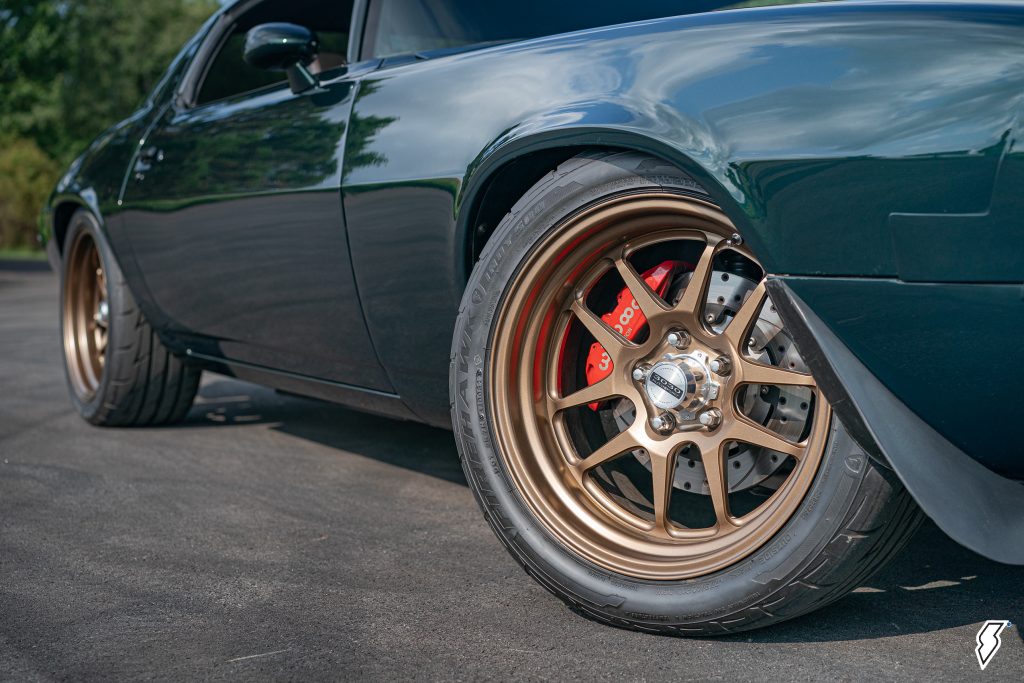
Ridetech suspension, forged aluminum 3030 Autosport G05Y wheels, and 275/40R18 Firestone Firehawk rubber at all four corners round out the package. Wilwood six-piston front/four-piston rear calipers clamp drilled-and-slotted rotors, scrubbing off speed with ease. Paul’s car still uses a steering box and leaf springs, though a Borgeson 12.7:1 box aims the front wheels and Ridetech composite monoleaf springs keep the axle from getting unruly.
A four-link may be in the car’s future, though. “The car runs good and rides good, but it’s firm. It’s more firm than the Nova was with the four-link,” Paul admitted.
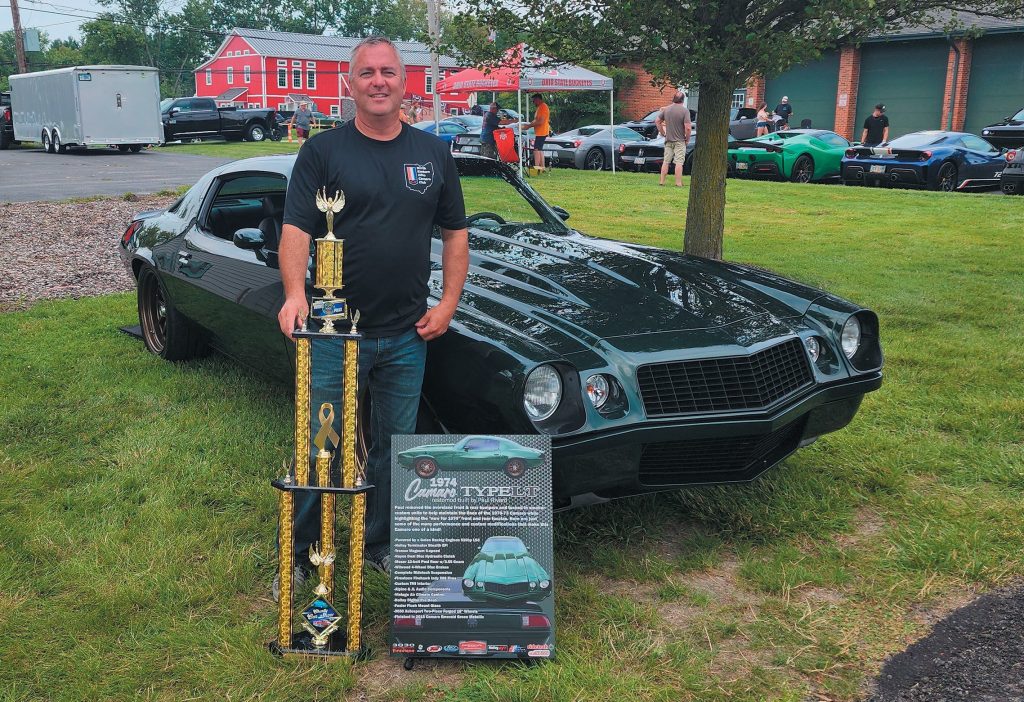
The build was finished in the spring of 2022, and by August 2023 had racked up 2,500 miles, along with plenty of car show trophies.
Paul’s happy with his creation, and no one’s calling this ’74 ugly.
“I like the whole car. I like the look of it, I like the stance, I like the handling. The power is great. But I love that other people appreciate what I did,” he said. “I think that’s just the biggest thing; I just built the car that was in my head. As I looked at the car, I’m like, ‘These bumpers gotta go.’ And I kept looking at it…‘Alright, I’ll take the license plate off the back.’ And it just evolved into this.”
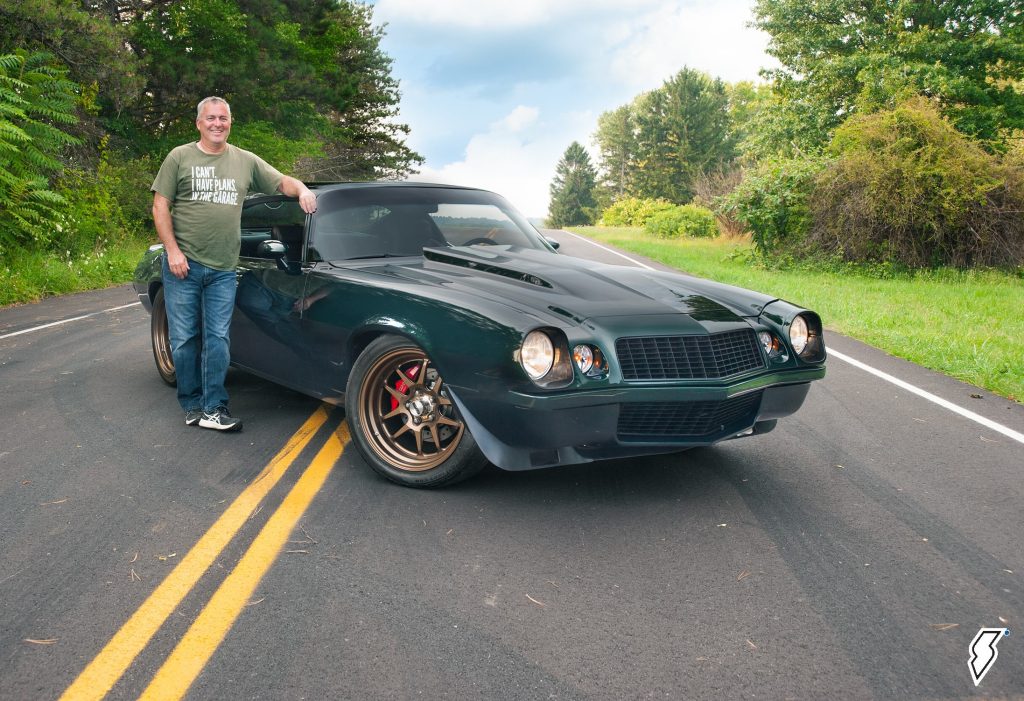
1974 Chevy Camaro Type LT Fast Specs
Owner: Paul Rivard – Tallmadge, OH
Chassis
- Frame rewelded, smoothed, and powdercoated
- Global West subframe connectors
- Borgeson 12.7:1 ratio steering box
- Ridetech StrongArm tubular front control arms and HQ Series coilovers, 1 1/4″ sway bar
- Ridetech StreetGrip composite leaf springs and HQ Series shock absorbers
- Wilwood 6-piston front/4-piston rear calipers, 12.19″ drilled and slotted rotors, and master cylinder with proportioning valve
Wheels & Tires
- 3030 Autosport G05Y 18″ x 9 1/2″ forged aluminum wheels (front/rear)
- Firestone Firehawk Indy 500 275/40R18 tires (front/rear)
Engine
- GM LS3, bored and stroked to 427 cu. in., built by Golen Engine Service, Hudson, NH
COMP Cams® custom-grind camshaft, lifters, pushrods, valve springs, and trunnion upgrade - Mahle forged 11.0:1 pistons and rings
- Callies Performance crankshaft and rods
- Clevite bearings
- LS Classic big block-style valve covers
- Holley mid-mount accessory drive system
Air & Fuel
- Holley Terminator Stealth EFI, single-plane intake manifold, and Sniper EFI fuel tank with 400 lph pump
- Summit Racing™ air filter
Ignition & Electrical
- LS3 ignition coils
- MSD 8.5mm Super Conductor spark plug wires
- Powermaster starter
- American Autowire wiring harness
Exhaust
Cooling
- Cold Case radiator and dual fans
- Silicone and aluminum hoses with Allstar Performance PowerGrip heat shrink hose clamps
Drivetrain
- TREMEC Magnum 6-speed transmission
- McLeod RXT twin-disc clutch
- Moser GM 12-bolt rear end with Auburn Gear limited-slip differential, Moser 3.55:1 ring and pinion and 30-spline axles
Exterior
- Low-profile bumpers, reworked front and rear valence panels, relocated rear license plate, Fesler flush-mount front and rear glass
- Metalwork and modifications by Paul Rivard
- Ridetech fuel filler
- Paint and final bodywork by Mike Beaulieu, Mike’s Auto Body, Merrimack, NH
- 2015 GM Emerald Green Metallic paint
Interior
- Upholstery by Ace Upholstery, Salem, NH, and Paul Rivard
- TMI front seats and rear seat covers
- Vintage Air A/C
- Modern Classics Interiors fiberglass dashboard and console
- Holley EFI 6.86 in. Pro Dash
- Alpine stereo head unit, JL Audio amplifier and subwoofer, Custom Autosound and Kicker speakers
Get a Closer Look at This Custom 1974 Camaro in This Video
Special thanks to: My wife Tanya for her patience and understanding; Dave Simoneau and John Rowbotham for their machine shop skills; Mike Beaulieu for years of bodywork class

Love it, I’ve always been a fan of the “big bumper” camaro’s and have often wondered if the bumpers from a 72-73 would fit and now I know the answer. Awesome looking ride.
The front of the car is the best rendition of a 2nd gen Camaro that I’ve ever seen IMO. I wish it was offered as a kit because I’d buy it! I do not have the skills or tools to build from scratch. Nice job, sir.